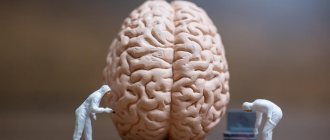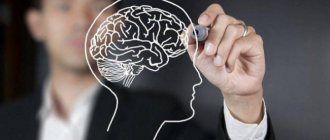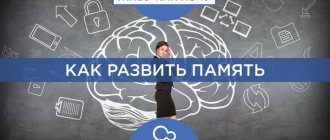Short-term memory is a special type of storing information. It includes operations that occur from the initial stage of memorization to the recording of traces of external influence. Subjectively, short-term memory can be considered as a reflection of an event that just happened - for another moment a person continues to see and hear what is no longer happening in real time. Short-term memory processes are unstable and reversible, last about 20 seconds, then disappear.
What is short-term memory
Short-term memory is the ability to retain information for a short period of time (20 to 30 seconds). The fading of the exact image begins already at 15-18 seconds, and by 30 it is already completely forgotten.
Forgetting in such a short period of time occurs when the goal is not to retain information for a long time. If a person intends to remember something, he transfers the received information to the level of long-term memory.
Short-term memory allows you to store information obtained from practical experience and used to perform habitual routine actions. So, a person can repeat a new phone number for some time and list the actions just performed.
Short-term memories play a very important role. If a person does not remember the actions he has just performed, he repeats them over and over again. The most striking example of short-term memory impairment is forgetting in Alzheimer's disease.
Short-term memory is a whole complex of cognitive abilities that can be trained. Main characteristics of this type of memory:
- Volume - for an adult, the minimum volume is 7 (+/-2) elements. The ability to hold more than 7 elements is a favorable sign. If a person retains less than 5 elements, this is regarded as a violation - diagnosis and work to eliminate (if possible) the problem, treatment is required.
- Filtering is the ability to discard information that is not valuable and retain important information. For example, in order to remember well the lecture material presented by the teacher, the student is not distracted by extraneous stimuli - the color of classmates’ clothes, noise from behind the door.
- The ability to transition to long-term memory - the accuracy of long-term memory directly depends on the volume of short-term memory.
Poorly encoded and stored short-term memory information passes into long-term memory in a distorted form, and the carrier (person) himself is not aware of this. This explains the fact that participants in the same events often describe them differently and consider their own account to be true.
If intelligence is connected to short-term memory, then the content of information becomes more important. For example, reinforcing information with visual stimuli (photos, paintings, tables, diagrams) allows you to remember it better, make it more structured, and reproduce it after some time.
Ways to improve memory
To train your memory and start thinking productively, to make the results of all memory processes perfect, you can use one of the methods presented below.
Impression
Any situation leaves its own impressions, any idea of anything is based on them. By paying attention to impressions and being vigilant about individual events and their “aftertaste,” you can train your memory.
By scrolling through impressions in your head and making connections between experiences and received emotions and experiences, you can get good results.
Association
This is another good way. When remembering something, memorizing materials, doing other intellectual work that requires memorization, you can use associations. This is the secret of a good memory. In the context of its training, it is worth considering the associative method as the replacement of complex forms of something with simple, understandable components connected to each other.
Repetition
Mother of learning. Psychologists consider repetition to be the basis of memorization. It's like learning the alphabet in kindergarten or primary school: only regular repetition allows children to remember the sequence of letters, their number and pronunciation.
It is obvious, for example, that any specialist who regularly works in one of the areas of professional activity, forced to repeat certain materials or refer to them again and again, eventually realizes that all the necessary information is stored in his head. He no longer needs to turn to sources that previously seemed necessary.
Special memory systems
This is about mnemonics. More precisely, about mnemonics. Memory development with their help can be carried out within several scenarios.
Remembering faces and names
The point is this: when communicating with people, showing interest in them, you need to call them by name more often, build associations with already familiar personalities, go through all the variations of names in your head (example: Natasha, Natalya, Natalie, Tanya). The same with faces: it is enough to look at a person more often when communicating, compare his appearance with the appearance of others. Noticing, highlighting and remembering characteristic features is easy. As easy as remembering a face.
By following the given conditional algorithm of actions, you can learn to remember faces and names and train your memory. This is not only interesting, but also useful.
Remembering things to do
In order not to forget who you needed to call or write, why and why, what you needed to buy in the store, you should learn to remember things. You need to translate them into images, mentally superimpose them onto familiar routes.
Example: a building that has 9 rooms. The first seven are the days of the week with things to do on them. Room No. 8 is things to do for a week (self-control), No. 9 is things to do for a month (self-control at a distance). A simple and effective technique.
Memorizing foreign words
This is where associations work best. Without delving into the theory, it’s worth moving on to examples.
There is an English word "look" (look). You can remember it through association with the Russian word “onion”. “Looking” at the “onion” is almost impossible: the eyes begin to water.
Another example based on associations is memorizing foreign words not in the form of translations into the native language, but as definitions of certain concepts, descriptions of objects, phenomena or processes. “Cup” – a cup with a handle. Having fixed an image in your mind, you can easily remember this and any other word.
Types of short-term memory
Short-term memory is divided into several types, based on how it is encoded.
Sound (auditory)
Information comes through the organ of hearing. For it to register, it is not enough just to hear. It is important to speak the information out loud or repeat it silently. Otherwise, the received information will disappear after 30 seconds.
Visual (visual)
Information comes through the organ of vision. To transfer a picture from the level of short-term memory to long-term memory, it is necessary to carry out phonological coding - say several times what a person sees (out loud or silently), select associations for what he saw.
Kinesthetic (tactile)
The process of memorization through tactile sensations. This type of memory does not actively work in all people. Kinesthetic learners must touch a thing, hold it in their hands, feel its warmth or cold, surface texture, weight in order to assimilate and consolidate information about it.
People with well-developed auditory memory easily reproduce heard information. To integrate new information into memory, visual learners must see it in the form of drawings, diagrams, notes. Practical work and experiments help kinesthetic learners remember information.
Basic memory processes
As part of the complex of abilities under consideration, it is customary to distinguish several main processes. They are discussed in detail below.
Memorization
This is the imprinting of perceived information, any acquired knowledge. A person becomes able to remember something after gaining experience interacting with certain objects and phenomena through sensations and perceptions. As a process, memorization can be voluntary and involuntary (analogy – voluntary and involuntary components of memory).
Preservation
This is holding something in memory. An example is training, when a student adopts the teacher’s manner of speaking and thinking and assimilates the information he offers. As a result of this operation, nerve connections are formed between cells, which literally line the nerve pathways - stored blocks of data.
Playback
This is the reconstruction of images that have been internalized and become stable, taking the form of templates thanks to the memorization and preservation of information about specific events. As a result of this process, previously formed neural connections are activated.
Forgetting
This is partial or complete erasing of specific fragments from memory. Memories associated with certain time periods, even long and important ones for the subject, are erased.
Some researchers link forgetting to the quality of retention of knowledge or patterns of experience.
Do you usually make a grocery list before going to the store?
Yes, because otherwise I might simply forget what I need to buy
25%
Only in case of a large purchase can I make a list
25%
I never make a list, I always focus on the spot
50%
Voted: 4
Stages
When a person is not faced with the task of remembering information, short-term memory works. The trace of an event or information disappears within 30-40 seconds. In a situation where there is a need to retain information for a longer period, memorization occurs in 3 stages.
Stage 1 - coding
To retain an image within short-term memory, you need to concentrate your attention on it - notice the most important thing, and ignore everything that is unimportant. Irrelevant information will be forgotten after 30 seconds.
For example, if you need to remember the amount spent on purchases, then after some time a person can easily reproduce the exact number. But he is unable to remember the name of the cashier, how many people stood in line in front of him - this unimportant information was supplanted almost immediately.
In people, information encoding in the structure of short-term memory occurs in different ways, using auditory, kinesthetic or visual types of perception.
- with acoustic encoding, in order to remember information, it is necessary to repeat it loudly or silently;
- visual encoding involves creating a powerful association with what you see. This type of coding is the main one in people with photographic memory;
- kinesthetic - memorization occurs through tactile sensations.
Short-term memory consists of two components - buffers (storage). Different brain structures are responsible for each of them. The first buffer (located in the left hemisphere of the brain) stores information received through the auditory organ. The second buffer (in the right hemisphere) is responsible for storing information received through the organ of vision
Stage 2 - storage
Long-term memory stores pictures from the past - childhood, school years, vivid events that happened not so long ago. Sometimes it seems that the memory store has no boundaries; you can find any memories in it. The situation is different for short-term memory. Its volume is minimal.
American psychologist George Miller defined a formula (7+/-2) that most accurately reflects the ability of the average adult to retain information. Short-term memory lasts no longer than 30-40 seconds. But due to various reasons, the duration and number of elements held may fluctuate in both directions.
The short-term memory formula is easy to check yourself. To do this, you need to quickly look through a small list (movies, names, products), turn around and try to reproduce it, and then count the number of items.
Retention of information by short-term memory occurs through consolidation and forgetting. Those who want to increase their ability to retain information need to understand what these two processes are.
Enlargement example
The task was set - to reproduce letters in a given sequence - Sruoyylerecnis - in a short period of time. For a person who has not previously studied English, it will be easy to repeat 5-7 letters. Anyone who speaks English will be able to retrieve the previously memorized phrase Sincerely Yours from long-term memory. As a result, he enlarges a given combination of 14 letters into two words that are very easy to remember.
The method of enlarging and retrieving associations from memory makes it possible to reduce the amount of information that needs to be stored.
Forgetting
Short-term memories are very quickly erased from memory due to fading and replacement by new ones. Extinction is due to the fact that attention is not focused on the information received. Even if a person immediately encoded it (said it out loud), then as soon as he told it to someone else or wrote it down on paper, the information disappears from memory, as if it had lost its relevance.
The image is erased for another reason. If you have to remember new information every day, then it is “overlaid” by more recent information. For example, it is quite easy to recite the amount spent in a store today and yesterday, but it is not easy to reproduce the amount on a receipt from two weeks ago.
Stage 3 - Reproduction
It seems that the process of reproducing newly received information is easier than restoring what was previously received. The reason for this illusion is the belief that in order to reproduce previously received information, you need to find it in storage, and only then release it, and in short-term memory the image “lies on the surface.”
But the more elements are contained in the repositories, the slower and less accurate the information is reproduced. Thus, a telephone number of 10 digits is extremely difficult to repeat without making at least one mistake. If the number contains only 6-7 digits, the probability of accurate reproduction is much higher (Miller's formula).
When training short-term memory, this must be taken into account. It is important not to try to memorize a large number of elements (words, numbers) at a time, but to gradually increase their volume.
By the nature of mental activity
Depending on what mental activity predominates in human activity during the recording and reproduction of information, there are the following types of memory.
Motor
Other names: motor.
Definition in psychology: fixation, retention and reproduction of motor algorithms, their amplitude, duration, speed, direction. It is formed in a part of the brain called the reticular activating system.
Why is it needed: contributes to the development of a number of skills (domestic, sports, labor), as well as learning to write.
Examples:
- the simplest movements that a person learns from childhood: how to walk, hold a spoon, brush your teeth, comb your hair;
- playing tennis, team sports, swimming, gymnastics, aerobics, exercise equipment;
- knitting, embroidery;
- cutting food, peeling vegetables and fruits;
- drawing, modeling, wood carving;
- dancing;
- playing musical instruments.
Who is especially well developed: athletes, secretaries, dancers, jewelers, watchmakers, surgeons, assembly line workers.
Development methods:
- Exercise. Master different sets of exercises.
- Develop fine motor skills (sculpt, assemble puzzles and Legos).
- To take dance classes. Learn new directions.
- Develop your hands.
- Learn to play musical instruments.
- Master the ten-finger touch typing method.
- Learn to use Chinese chopsticks.
- Perform exercises that involve completely different movements with your hands (for example, the left hand strokes the table in a circular motion, and the right hand, clenched into a fist, knocks on the table).
Emotional
Definition in psychology: fixation, retention and reproduction of feelings experienced by a person, as well as emotionally charged events. They can be positive and negative. They are formed by a part of the temporal part of the brain called the amygdala. They are deposited in the cerebral cortex. Thanks to the plasticity of the central nervous system, with each subsequent reproduction of the same situation, its brightness is smoothed out.
Why is it needed: feelings experienced and recorded by emotional memory become a kind of signaling system for a person. It either encourages him to act (if the experience was positive) or deters him from it (if the experience was negative). Forms a versatile personality, develops emotional intelligence, promotes social adaptation, and stimulates creativity.
Examples:
- empathy, sympathy (based on experience);
- Love;
- complexes;
- phobias;
- choice of social circle (people move away from those who hurt them in the past).
Who is especially well developed: actors (the famous system of K. S. Stanislavsky is based on it), teachers, psychologists, representatives of social professions.
Development methods:
- Keeping a diary.
- Meditation.
- “Anchoring” positive feelings and emotions.
- Bibliotherapy.
- Master networking and make as many new acquaintances as possible.
- Do what you like.
- Adrenaline: ride a roller coaster, jump from a parachute.
This is interesting. Psychologists say that a person remembers 3 feelings best - fear, suffering, surprise.
Semantic
Other names: verbal, logical, verbal-logical.
Definition in psychology: fixation, retention and reproduction by a person of heard, seen, spoken words.
Why is it needed: allows you to record and reproduce information based on generalized associations that reflect its most important aspects. Uses large structural units for memorization, which are called mnemonic supports. After a while, they are the ones who help a person remember the material.
Examples:
- retelling;
- memorizing poems;
- preparation for exams.
Who is especially well developed: artists, singers, pupils, students.
Development methods:
- Break information into blocks and isolate main ideas.
- Read complex texts every day that are far from your interests, try to understand and remember the information contained in them.
- Before going to bed, remember in detail the past day (week, month, quarter, six months, year).
Figurative
Other names: visual-figurative.
Definition in psychology: fixation, retention and reproduction of visual and sound images, as well as odors.
Why is it needed: to control the balance of functioning of both hemispheres of the brain.
Subtypes:
Who is especially well developed: musicians, artists, writers.
Development methods:
- Master the association method.
- Do neuroscience.
- Learn foreign languages.
This classification is considered basic in psychology. Particular attention is paid to the figurative type.
Related article: How to develop memory
Short-term memory: possible problems and disorders
Problems with short-term memory can be caused by pathological conditions in which the information received is not retained. Short-term memory disorders are very common, they occur in every 4 inhabitants of the planet.
In most cases, problems arise in older people; their memory impairment is permanent or episodic. Impaired ability of young people to retain received information interferes with learning and does not allow them to concentrate on work.
People with short-term memory impairments remember events of the past well (what happened several years, decades ago), but are not able to answer the question of what just happened.
Problems with short-term memory can be caused by the following conditions:
- depression - when the balance of hormones and neurotransmitters in the brain is disrupted, the ability to concentrate is lost because of this;
- ischemic stroke - against its background, the blood supply to the brain is disrupted, oxygen starvation of the organ occurs;
- psychological trauma - the psyche prevents the preservation of painful information, displaces it into the unconscious. Associated with this reaction is the phenomenon when a person in a state of passion cannot remember what happened within a few minutes;
- traumatic brain injuries impair short-term memory;
- bad habits (smoking, drinking alcohol, drugs) improve the supply of oxygen to the brain.
Problems with short-term memory arise against the background of the appearance of tumors in the brain, as well as in Alzheimer's disease and schizophrenia. The reason for forgetting the events that just happened may be severe physical exhaustion, lack of sleep, severe infectious processes (HIV, tuberculosis, syphilis).
A violation can be suspected by the lack of logic during reasoning, confusion of thoughts and consciousness, and fragmentary memories. A person with a problem has deteriorating vision - spots flicker before the eyes, blurry pictures appear. Other symptoms of the anomaly also occur:
- depressed state, increased anxiety;
- thinking and cognitive abilities, the process of perception, and mastery of skills deteriorate;
- Muscle spasms occur and coordination of movements is impaired.
Deterioration of short-term memory affects the quality of life, greatly reducing it. At the first difficulty with remembering, it is necessary to be examined and, if necessary, undergo treatment.
Diagnosis of decreased short-term memory ability involves:
- determining the volume and duration of storage of received information;
- study of the basic processes of memory - memorization, storage, reproduction.
To diagnose each of the components of short-term memory, use:
- Hinrichs guessing method (for duration research);
- Jacobs, Sperling, Vuchetich/Zinchenko tests;
- Luria/Leontiev test of Vysotsky pictograms (memorization process);
- Ebbinghaus method (conservation);
- the process of information reproduction is studied using the methods of a given standard, reconstruction, saving, and sequential reproduction.
Each of the diagnostic methods used carries out a valeological assessment of short-term memory, taking into account physiological factors. The diagnostician takes into account age, gender, health status at the time of the study and the presence of chronic pathologies. To obtain the most reliable results, testing is repeated several times.
In some cases, neuropsychological diagnosis may not be sufficient. If organic brain damage is suspected, in which short-term memory is impaired, doctors recommend undergoing neurosonography, MRI of the brain, and electroencephalogram.
How short-term memory develops
You can improve your cognitive abilities and improve your short-term memory through regular exercise. Neurologists and neuropsychologists recommend:
- online brain trainers;
- method of repeated repetition (reproduce the same information at intervals of several hours or days);
- simplify (enlarge) the material so that it is easier to remember;
- use figurative and associative thinking;
- add an emotional component, making the information more vivid.
Intellectual games, memorizing poetry, and learning foreign languages are of great benefit.
| The principle of improving memory | Method to improve memory |
| interest | interesting things are easy to remember |
| comprehension | deeply understood information is remembered well |
| installation | if a person is determined to remember information, then it is well absorbed |
| action | information that can be applied in practice is absorbed very well |
| context | associative linking helps to remember information |
| braking | when learning new information, the old one “overlaps” |
| repetition | repetition helps to retain information well |
| optimal row length | the information to be learned should not be much longer than the capacity of short-term memory |
A person’s lifestyle also affects their ability to remember. Therefore, experts recommend:
- give up bad habits - smoking, alcoholism, drug addiction;
- sleep at least 7-8 hours a day;
- walk in the fresh air at least 1 hour a day;
- avoid stressful situations;
- alternate mental and physical activity;
- eat a balanced diet.
Neurologists prescribe a course of treatment with drugs to improve cerebral circulation in patients with incipient cognitive problems. If a tumor is present, surgery is considered. In most cases, an integrated approach makes it possible to restore short-term memory or slow down its decline.
Irina Sherbul











